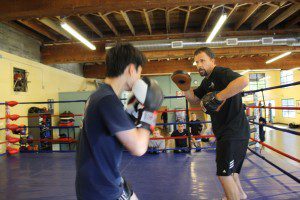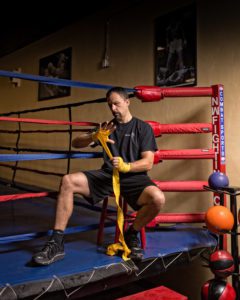 Boxing Footwork. When taking up the art of boxing there is a basic progression of ideas, techniques and strategies that you need to understand.
Boxing Footwork. When taking up the art of boxing there is a basic progression of ideas, techniques and strategies that you need to understand.
First is your stance and foundation. If you are not solid in your stance it will be difficult to defend attacks and you will have no power or mobility with your offensive techniques.
Next you need to be able to move around the ring while maintaining this solid foundation. This is where developing your boxing footwork will help you become successful in the ring.
There are many different footwork patterns that will get moving around the ring. With this article I will talk about developing the basic footwork patterns that are essential in the art of boxing.
Different Boxing Footwork Techniques:
1- The Half Step
This is a fairly simple practice to develop. It can be used in many different scenarios. It will help you to understand the idea of weight transfer. Weight transfer is essential for developing powerful strikes. It will also help to bridge the gap offensively when delivering attacks. One other benefit of this footwork is to use it defensively. Both for retreating to evade the strikes of your opponent and side stepping to evade and change the angle for counter attacks.
2- The Shuffle Step
This is a basic footwork used to move in, out, left and right. It will give you more distance than the half step because you will be traveling with both feet. This footwork is used for controlling your real-estate in the ring. It will give you the ability to attack offensively and defensively. You can change the angle of your opponents attack and use the footwork to cut off your opponent when he is trying to control the ring.
3- 1/4 and 1/8 Turns
This footwork strategy has many applications. The 1/4 turns is done by pivoting on the lead foot and turning your stance 90 degrees left or right. A common mistake beginner pugilists will make is, as they are turning, they will land with a narrow stance not keeping their feet hip width. So when practicing this footwork pause and check the width of your feet after you turn and make sure you are in a solid stance facing the direction of your opponent.
The 1/8 turns are similar to the 1/4 turns the only difference is that you turn 45 degrees instead of 90. Both of these footwork drills will help with angling giving you the ability to attack on unexpected angles and defend straight line attacks.
 In the beginning you will want to isolate these footwork strategies and work towards making them strong and smooth. As you start to develop skill with these basic footwork strategies then you can start to combine them. There are hundreds of ways you can put these together using different counts and changing the rhythm.
In the beginning you will want to isolate these footwork strategies and work towards making them strong and smooth. As you start to develop skill with these basic footwork strategies then you can start to combine them. There are hundreds of ways you can put these together using different counts and changing the rhythm.
Learn to master these techniques; they will give you the fundamental skills you will need to become a good boxer. If you are in the Portland, OR area check out a Free Trial lesson at Northwest Fighting Arts.



